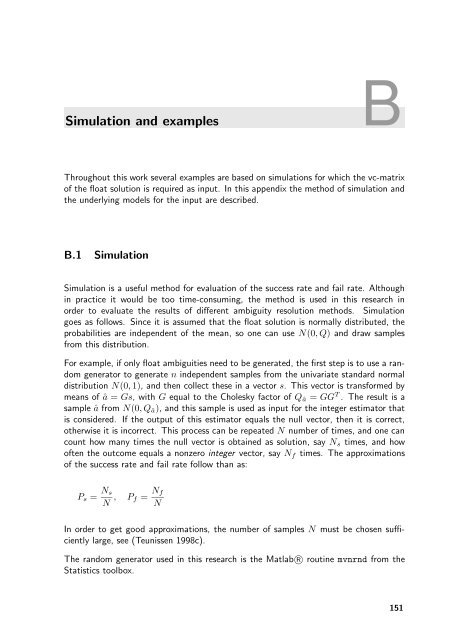The GNSS integer ambiguities: estimation and validation
The GNSS integer ambiguities: estimation and validation
The GNSS integer ambiguities: estimation and validation
You also want an ePaper? Increase the reach of your titles
YUMPU automatically turns print PDFs into web optimized ePapers that Google loves.
Simulation <strong>and</strong> examples B<br />
Throughout this work several examples are based on simulations for which the vc-matrix<br />
of the float solution is required as input. In this appendix the method of simulation <strong>and</strong><br />
the underlying models for the input are described.<br />
B.1 Simulation<br />
Simulation is a useful method for evaluation of the success rate <strong>and</strong> fail rate. Although<br />
in practice it would be too time-consuming, the method is used in this research in<br />
order to evaluate the results of different ambiguity resolution methods. Simulation<br />
goes as follows. Since it is assumed that the float solution is normally distributed, the<br />
probabilities are independent of the mean, so one can use N(0, Q) <strong>and</strong> draw samples<br />
from this distribution.<br />
For example, if only float <strong>ambiguities</strong> need to be generated, the first step is to use a r<strong>and</strong>om<br />
generator to generate n independent samples from the univariate st<strong>and</strong>ard normal<br />
distribution N(0, 1), <strong>and</strong> then collect these in a vector s. This vector is transformed by<br />
means of â = Gs, with G equal to the Cholesky factor of Qâ = GG T . <strong>The</strong> result is a<br />
sample â from N(0, Qâ), <strong>and</strong> this sample is used as input for the <strong>integer</strong> estimator that<br />
is considered. If the output of this estimator equals the null vector, then it is correct,<br />
otherwise it is incorrect. This process can be repeated N number of times, <strong>and</strong> one can<br />
count how many times the null vector is obtained as solution, say Ns times, <strong>and</strong> how<br />
often the outcome equals a nonzero <strong>integer</strong> vector, say Nf times. <strong>The</strong> approximations<br />
of the success rate <strong>and</strong> fail rate follow than as:<br />
Ps = Ns<br />
N , Pf = Nf<br />
N<br />
In order to get good approximations, the number of samples N must be chosen sufficiently<br />
large, see (Teunissen 1998c).<br />
<strong>The</strong> r<strong>and</strong>om generator used in this research is the Matlab R○ routine mvnrnd from the<br />
Statistics toolbox.<br />
151
















